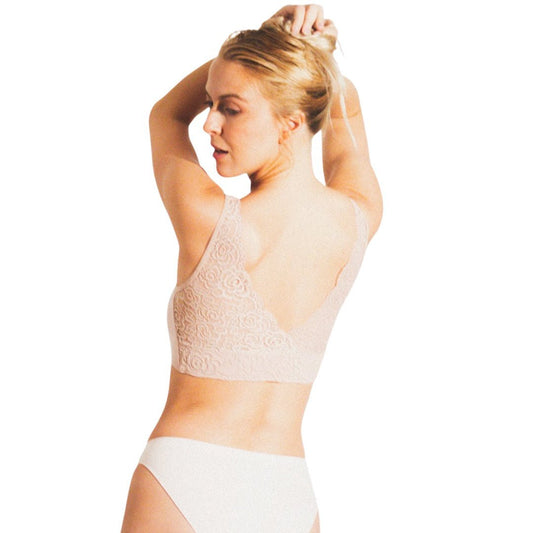
The Right Way to Measure Your Bra Size: The Rib Cage Method
Wearing a properly fitting bra can make a world of difference in your comfort and confidence. Yet, many women are still using outdated methods to determine their bra size. In this article, we will guide you through the correct way to measure your bra size using the rib cage method and dispel common misconceptions such as measuring at the armpit level or adding 4 inches to your band size.
Breaking Down the Bra Size Confusion
When you’re sorting through bras sizes, like deciding if you need a cup size A, B, C, or beyond, it’s crucial to look past the old-school methods. The plus four method is outdated, and it's been leading us astray. BRABAR is at the forefront of the movement for change, advocating the rib cage method to size a bra correctly.
Math Examples and the Rib Cage Method
Let's get into some examples. If your bust measure is 33 inches and your underbust (rib cage) is 29 inches, traditional methods would have you add four, placing you in a 34 band – but this isn't snug. In reality, rounding your underbust to the nearest even number, you're likely a comfortable and supportive 30C or 30D, depending on the exact bust measurement.
Why the Plus Four Method Fails
The plus four method would turn that 29-inch rib cage into a 33-inch band, comparing it to a bust size of 33 inches. The irony? This method leads you to an A cup, which is significantly off from what you would need. If a woman with a 28-inch underbust and a 33-inch bust used this antiquated method, she would be incorrectly advised to wear a 32A, instead of embracing the more accurate 28DD.
The BRABAR Movement: A Call to Arms
At BRABAR, the push for standardizing the rib cage method is more than a campaign – it's a battle cry. Eight out of ten women are in the wrong bra size because they've been taught to measure incorrectly, using the armpit instead of the rib cage. By adopting the rib cage method, every woman and girl, from teenage bras wearers to mature women, can find their true size.
Promoting the Strapless Bra Fit
The philosophy is simple: a bra, especially a strapless bra, should fit snugly like a hug around your rib cage. It's the band that does the heavy lifting, not the straps. The BRABAR method ensures 80% of your support comes from the band, which should fit like the best strapless bra – firm and level all the way around your body.
From my school locker to weekend hangouts, the quest for the perfect 'bra in' my life is real. I'm diving headfirst into the world of sports bralettes because comfort is queen when you're on the move.
Understanding 'bust size to cup size' is like cracking a secret code, but once you get it, it's a game changer. Finding the 'cup size for bra' that fits just right makes all the difference. That's why I'm all about that fit guide life, getting my 'sizes in bras' on point.
Talking 'cup size in a bra' with friends is the norm. We swap stories of our 'sizes for bra' misadventures and triumphs because 'bras sizes' are as varied as our personalities. And when you find that perfect 'cup size a bra', it's like winning the lottery.
I've learned 'bust size in bra size' is more than a number—it's about feeling confident. Whether it's 'bust size to bra size' or the fit of 'cup size in bra', it's personal. My mom showed me a 'sizing chart for bras' when I first started shopping, and we found out I'm a 'cup sizes for bra' that's not always easy to find in stores.
But here's the thing: 'bra size' isn't just about numbers and letters. It's about how you feel when you slip on that 'size a bra size'. Whether it's 'cup size in bras' or the snug fit of a 'cup bra measurement', it's about support—both physically and emotionally.
'Brassiere sizes' and 'brassiere sizes' can be baffling, but they don't have to be. 'Sizes of the bra' and 'size in bras' become clearer with a brand like BRABAR that gets it. Their 'cup sizes of bra' range and 'brassiere size' options have me covered.
Their 'bra measure chart' and 'size chart bra' guide you like a GPS through the 'sizing for a bra' journey. With their 'cups bra sizes' and 'bras sizes chart', you're sure to find your fit. It's why I trust their 'cup sizes for bras' every time.
For 'bra a size' and especially 'cup size bra measurement', they make it seem so simple. Their 'cup sizes in bras' and 'size chart for bra' take the stress out of shopping. Even my 'bra bust sizes' feel catered to.
It's a relief that 'sizes for bras' are no longer a mystery. And learning 'how to measure cup size on a bra' is empowering. From 'how to measure a bra cup size' to 'how to measure the bust size', it's all about knowledge.
'How to measure bra size and cup size' isn't daunting anymore, thanks to BRABAR's guide. And 'strapless bralettes'? They've got those too, making 'how to measure bust size for a bra' worth the effort.
As for 'how to measure size for a bra', it's about finding that sweet spot. Whether it's 'how to measure a cup size' or 'how to measure cup size for bra', it's a skill every girl should have. Thanks to BRABAR's fit guide, we're all becoming pros at 'how to measure bra size' and 'how to check bra size'.
So, let's say goodbye to the confusion. With BRABAR, 'how to measure the bra size' and finding the perfect 'bra for strapless' dresses is a breeze. It's about comfort, confidence, and the right 'cup size'. After all, a 'c cup bra measurement' might not be the same as a 'b cup bust size', but they're both beautiful.
Remember, 'bra size for c cup' or 'a bras', it's all about that perfect fit. So let's embrace the 'breast measurements', find our 'a bra', and celebrate every 'c cups' and 'bust size to cup' out there. Because with BRABAR, every girl can find her 'cup size'.
Concluding with a Call for Change
BRABAR isn’t just selling bras; we’re selling a revolution in bra fitting. With our fit guide, we’re dismantling the confusion one bra at a time. So whether it’s a sports bralette for your active teen or a lace bra for yourself, remember: the best fit is one that feels right, supports right, and looks right. Join us in redefining the standards, one rib cage at a time.
Learn How to Measure Your Bra Size
The Importance of Accurate Measurements
Before delving into the rib cage method, it's essential to understand why accurate measurements are crucial. A well-fitting bra provides support, comfort, and enhances your silhouette. An ill-fitting bra can lead to discomfort, back pain, and even posture issues. To avoid these problems, let's explore the correct method for determining your bra size.
The Rib Cage Method: Step by Step
-
Get Prepared: To begin, you'll need a soft measuring tape, a mirror, and a non-padded, non-wired bra. Stand in front of the mirror wearing your best-fitting non-padded bra.
-
Measure Your Band Size: Start by measuring your underbust, right under your bust, where your bra band sits. Make sure the measuring tape is snug but not tight against your skin. This measurement is your band size.
-
Ignore the Armpit Level: A common mistake is measuring at the armpit level to determine your band size. This method is incorrect because it includes the width of your ribcage, leading to an oversized band size.
-
Understanding the Band Size: Your band size corresponds to the number in your bra size (e.g., 32, 34, 36, etc.). It is a direct measurement and should not be altered or adjusted.
-
Measure Your Bust Size: Next, measure around the fullest part of your bust while keeping the tape comfortably taut but not too tight. This measurement is your bust size.
-
Calculating Your Cup Size: To determine your cup size, subtract your band size (underbust measurement) from your bust size. Use the difference to find your cup size on the bra size chart:
- 1 inch difference = A cup
- 2 inches difference = B cup
- 3 inches difference = C cup
- 4 inches difference = D cup
Debunking the "Add 4 Inches" Myth
Now, let's address the misconception of adding 4 inches to your band size with a fit guide. This outdated practice +4 was once employed to provide additional comfort but is no longer relevant due to advances in bra design and materials.
Adding 4 inches to your band size will result in a band that is far too loose, causing inadequate support and an improper fit. Additionally, this practice impacts your cup size. For example, if your true band size is 32 inches and you add 4 inches, you get 36 inches. With a bust measurement of 36 inches, your cup size will now be incorrectly calculated as AA, when in fact, you may need a larger cup size like a C or D.
Accurate measurements are the key to finding the perfect-fitting bra. By using the rib cage method, you can determine your band and cup size correctly. Remember, there's no need to add 4 inches to your band size or measure at the armpit level. Embrace your true bra size, and you'll experience the comfort and support that a well-fitted bra can offer, enhancing your daily comfort and confidence.
The Perfect Fit for Every Game and Giggle: Sports Bras and Bralettes for Active Girls
From the bustle of the hallways to the buzz of the field, girls and young women are constantly on the move. For all the athletes, the dancers, and the unstoppable spirits, the right support is key. Whether you're a size 28AA, 28DDD, 34B, 36D, 38B, or 38DD, there's a sports bra or bralette out there crafted just for you.
Active Lives & Supportive Strides
For the young athlete juggling school, sports, and social life, the quest for the perfect sports bra is about more than just comfort—it’s about confidence. Our sports bralettes are made for every sprint, serve, and stretch, designed to support low to medium-impact activities.
Whether it's volleyball practice, yoga class, or a brisk walk between classes, these wire-free, versatile bras ensure comfort and style don't have to be mutually exclusive. They're the companions for every leap and lounge, every point scored, and every peaceful moment of relaxation afterward.
For Every Sport, A Style
In the diversity of activities that fill the days of girls and young women, different sports demand different types of support. That's why our range includes options for every activity. From halter-style sports bralettes that offer both fashion and function to full-coverage designs for those who need it most, we understand that one size does not fit all—literally and figuratively.
Our Pretty Halter Style Sports Bras are a hit for those who want to make a statement with their straps while keeping everything in place. And for the girl who’s just found her passion for the track, the best bras for AA-C cup provide the right amount of support as she finds her pace.
Embracing Every Size
No two bodies are the same, which is why our sizing guide is as unique as the girls and young women we serve. From those stepping into their first 28AA to the young woman seeking the comfort of a 38DD, our fit guide ensures you find the fit that feels as if it was made just for you.
The BRABAR Movement: Change We Wear
We at BRABAR are not just selling bras; we're spearheading a movement for change. We're advocating for the standardization of bra sizing to make it easier and more intuitive for girls and young women to find their fit. The rib cage method rounds to the nearest even number, providing a snug, supportive base that’s essential, especially for sports bras.
Join us in the movement. Embrace your size, your sport, and your style with a bra that's as ready for action as you are. Stay active, stay stylish, and most importantly, stay you.




